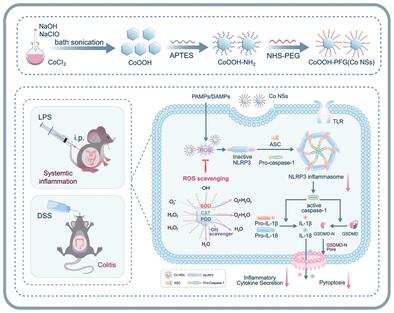当前位置:
X-MOL 学术
›
Adv. Funct. Mater.
›
论文详情
Our official English website, www.x-mol.net, welcomes your
feedback! (Note: you will need to create a separate account there.)
2D Cobalt Oxyhydroxide Nanozymes Inhibit Inflammation by Targeting the NLRP3 Inflammasome
Advanced Functional Materials ( IF 18.5 ) Pub Date : 2023-04-19 , DOI: 10.1002/adfm.202214693 Ziying Chen 1 , Pin Chen 2 , Yangyang Zhu 1 , Jieying Qian 3 , Xiaowan Huang 3 , Wang Zhang 1 , Hao Zhang 1 , Qing Mo 2 , Yutong Lu 2 , Yunjiao Zhang 1, 3
Advanced Functional Materials ( IF 18.5 ) Pub Date : 2023-04-19 , DOI: 10.1002/adfm.202214693 Ziying Chen 1 , Pin Chen 2 , Yangyang Zhu 1 , Jieying Qian 3 , Xiaowan Huang 3 , Wang Zhang 1 , Hao Zhang 1 , Qing Mo 2 , Yutong Lu 2 , Yunjiao Zhang 1, 3
Affiliation

|
Nucleotide-binding domain and leucine rich repeat family pyrin domain containing 3 (NLRP3) inflammasomes are implicated in diverse inflammatory diseases, so their activation needs to be tightly controlled. Over generation of reactive oxygen species (ROS) is a key factor in NLRP3 inflammasome activation. Consequently, nanozymes with ROS scavenging ability are potential inhibitors of NLRP3 activation and promising therapeutic agents for related inflammatory diseases. Herein, a type of 2D cobalt hydroxide oxide nanosheets (Co NSs), a nanozyme with excellent multienzyme-like activity, possessing peroxidase (POD), catalase (CAT), and superoxide dismutase (SOD) activities, exhibits superior ROS scavenging properties and protects cells from oxidative damage. Density functional theory (DFT) calculations further reveal these enzyme-like catalytic reactions of ROS eliminating are spontaneous and CAT is dominant under physiological conditions. Performing multienzyme properties, Co NSs present excellent anti-inflammation activity by blocking NLRP3 oligomerization and ASC speck formation, thereby inhibiting NLRP3 inflammasome assembly and activation. Importantly, treatment with Co NSs attenuates the severity of LPS-induced systemic inflammation and DSS-induced colitis. This study highlights a successful strategy for utilizing cobalt-based nanozymes to scavenge ROS and provides valuable insights into the underlying mechanism, demonstrating the potential therapeutic effects of nanozyme for the prevention and treatment of NLRP3-associatied inflammatory diseases.
中文翻译:

2D 羟基氧化钴纳米酶通过靶向 NLRP3 炎症小体抑制炎症
核苷酸结合域和富含亮氨酸的重复家族pyrin结构域3 (NLRP3)炎症小体与多种炎症性疾病有关,因此需要严格控制它们的激活。活性氧 (ROS) 的过度产生是 NLRP3 炎症小体激活的关键因素。因此,具有ROS清除能力的纳米酶是NLRP3激活的潜在抑制剂,也是相关炎症疾病的有前景的治疗剂。在此,一种二维氢氧化钴氧化物纳米片(Co NSs)是一种具有优异多酶样活性的纳米酶,具有过氧化物酶(POD)、过氧化氢酶(CAT)和超氧化物歧化酶(SOD)活性,表现出优异的ROS清除性能并保护细胞免受氧化损伤。密度泛函理论(DFT)计算进一步揭示了这些消除ROS的酶样催化反应是自发的,并且在生理条件下CAT占主导地位。Co NS 具有多酶特性,通过阻断 NLRP3 寡聚化和 ASC 斑点形成,从而抑制 NLRP3 炎症小体组装和激活,从而表现出优异的抗炎活性。重要的是,Co NS 治疗可减轻 LPS 诱导的全身炎症和 DSS 诱导的结肠炎的严重程度。这项研究强调了利用钴基纳米酶清除 ROS 的成功策略,并为潜在机制提供了有价值的见解,证明了纳米酶在预防和治疗 NLRP3 相关炎症性疾病方面的潜在治疗作用。
更新日期:2023-04-19
中文翻译:

2D 羟基氧化钴纳米酶通过靶向 NLRP3 炎症小体抑制炎症
核苷酸结合域和富含亮氨酸的重复家族pyrin结构域3 (NLRP3)炎症小体与多种炎症性疾病有关,因此需要严格控制它们的激活。活性氧 (ROS) 的过度产生是 NLRP3 炎症小体激活的关键因素。因此,具有ROS清除能力的纳米酶是NLRP3激活的潜在抑制剂,也是相关炎症疾病的有前景的治疗剂。在此,一种二维氢氧化钴氧化物纳米片(Co NSs)是一种具有优异多酶样活性的纳米酶,具有过氧化物酶(POD)、过氧化氢酶(CAT)和超氧化物歧化酶(SOD)活性,表现出优异的ROS清除性能并保护细胞免受氧化损伤。密度泛函理论(DFT)计算进一步揭示了这些消除ROS的酶样催化反应是自发的,并且在生理条件下CAT占主导地位。Co NS 具有多酶特性,通过阻断 NLRP3 寡聚化和 ASC 斑点形成,从而抑制 NLRP3 炎症小体组装和激活,从而表现出优异的抗炎活性。重要的是,Co NS 治疗可减轻 LPS 诱导的全身炎症和 DSS 诱导的结肠炎的严重程度。这项研究强调了利用钴基纳米酶清除 ROS 的成功策略,并为潜在机制提供了有价值的见解,证明了纳米酶在预防和治疗 NLRP3 相关炎症性疾病方面的潜在治疗作用。


















































 京公网安备 11010802027423号
京公网安备 11010802027423号